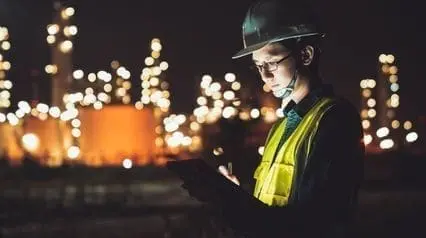Legal or Illegal?
Working alone or in an isolated environment is inherently high-risk, and working alone at night may increase lone workers’ exposure to theft, violence, and other threats. However, the short answer is that it is legal for employees to work alone at night—so long as their employers are complying with their general duties of care.
The Legality of Working Alone at Night
Lone Worker Safety in the United States
So is it legal to work alone at night in Texas, Florida, Ohio? And what about other states? In the United States, there is no federal law stating that it is illegal to work alone at night.
However, all American employers must comply with the health and safety standards put forth in the Occupational Health and Safety (OSHA) Act of 1970. The General Duty Clause states that each employer “shall furnish to each of his employees employment and a place of employment which are free from recognized hazards that are causing or are likely to cause death or serious physical harm to his employees.”
Furthermore, OSHA’s Section 1915.84 – Working alone provides specific regulations for employers with lone workers, stating:
Whenever an employee is working alone, such as in a confined space or isolated location, the employer shall account for each employee:
- Throughout each workshift at regular intervals appropriate to the job assignment to ensure the employee’s safety and health; and
- At the end of the job assignment or at the end of the workshift, whichever occurs first.
If employers comply with these regulations, then there should be no legal issues with employees working the night shift alone.
Lone Worker Safety in Australia
Similarly, in Australia, there is no law stating that employees cannot work by themselves at night.
However, the Work Health and Safety Act 2011 dictates that a business must ensure, so far as is reasonably practicable, that work environments are without risks to health and safety; there are safe systems of work; information, training, instruction or supervision necessary for safe work are provided; and the health of workers and workplace conditions are monitored to prevent illness or injury.
Lone Worker Safety Worldwide
Of course, organizations are bound by their local area’s safety legislation. It is important to research your local laws, take all practicable steps to safeguard your lone workers, and seek legal counsel where necessary. However, more often than not, it is completely legal for employees to work alone at night, so long as employers are carrying out their general duty of care.
As general, practical advice, all employers should ask themselves these two questions:
- Is it safe for my employees to work alone at night?
- If it is not, what reasonable steps can I take to mitigate the risks associated with my employees working alone at night?
How to Safeguard Nightshift Lone Workers
There are a number of ways that employers can safeguard lone, isolated, and remote workers—no matter what time it is.
Conduct Lone Worker Risk Assessments
According to OSHA, many workplace illnesses, injuries, and other incidents stem from employers failing to identify hazards that are either present or that could have been anticipated. Carrying out a lone worker risk assessment can help employers identify potential hazards and create an actionable plan to mitigate risks and safeguard their lone workers.
Undoubtedly, in addition to industry-specific risks, you will find that the main risk lone workers face is the act of working alone itself. Without supervision or access to backup support, even minor incidents can lead to tragedy. Deploying a lone worker safety solution, such as a panic button app, helps reduce the risk of working alone, in isolated environments, and confined spaces.
Night Work Risk Assessments
If you employ many different night workers, or if they perform different tasks than your daytime staff, it may be a good idea to conduct a dedicated night work risk assessment.
You will not know what specific risks your nighttime staff face until you complete a risk assessment, though employers often find that there is an increased risk of physical threats and violence, such as robbery, because lone night shift staff may be seen as easy targets.
In addition to a lone worker solution, you may find that other security systems, such as security cameras, motion-sensor lights, and entry alarm systems, are worth implementing.
Create a Lone Worker Policy
Another key way to protect lone-working employees is creating a go-to lone worker policy, which is a document that outlines an organization’s commitment to safeguarding its employees who work alone.
Your lone worker policy should outline general guidance for working safely, potential hazards and risks, staff members’ roles and responsibilities, clear and simple safety procedures and processes to follow, tools to use, how to assess and report incidents, and what to do if an emergency arises.
It is wise to create a section specifically dedicated to night work, so that employees know how to request and receive emergency assistance.
Deploy a Lone Worker Safety Solution
One of the most effective ways to safeguard lone, isolated, and remote workers is by deploying a lone worker app.
You should look for a lone worker solution that offers features such as real-time location sharing, duress/panic activation, man-down detection, automated check-ins, overtime alerts, and optional 24/7 security monitoring (for employees who work night shifts or outside of normal business hours).
“SHEQSY gives us peace of mind that our providers in the community have an easy-to-use tool that helps to keep them safe. This allows us to have oversight of where they are and, if required, their last-known location, without extra workload or actions for our providers to do throughout the day.” – Verity, TBI Health



